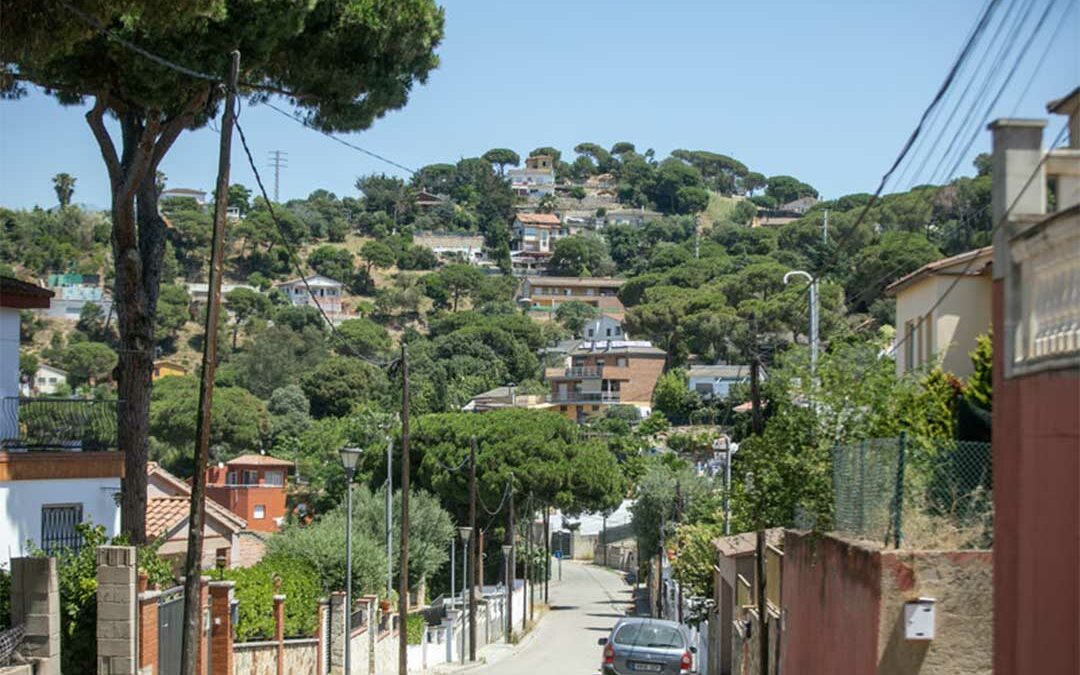- In Catalonia, there are close to 1,500 registered urbanisations, almost half of which are not regularised by the town councils
- The law prohibits granting licences and investing public money until the owners complete the pending urbanisation works — Elena Ferran – Sant Cebrià de Vallalta
In-depth study.
The Barcelona Provincial Council has a catalogue of 367 urbanisations with deficits, spread across 118 municipalities, where the councils must carry out pending service works that have to be paid for by the residents. Since 2018, when they began the study, they estimate they have helped bring about a dozen urbanisations up to date with services and transfer them into the hands of the councils so they can assume maintenance.
- 83% of the urbanisations do not have basic urban services or have them in poor condition.
- 74% are areas with no shops or establishments of any kind.
- 50% of residential areas have no facilities.
- 70% of residents have an average purchasing power, but the other 30% is highly uneven, with very low or very high incomes.
- 20% of the urbanisations are located on non-developable land, such as specially protected natural parks.
The boom in isolated and scattered urbanisations built in the late 1950s, 1960s and 1970s across the country has become a problem from a territorial, environmental, urban planning and socio-economic point of view. In Catalonia there are, according to the census carried out by the Generalitat in 2015, nearly 1,500 urbanisations, around 730 of which—almost half—are not regularised by the councils, which cannot maintain them until the plot owners pay for the pending urbanisation works that were not carried out at the time. The vast majority suffer from deficits affecting basic services that are non-existent or precarious, such as sewerage, water supply, street lighting and the paving of roads and pavements. Legally, other shortcomings are detected, such as plots not registered in the property register and urbanisations that have not made the mandatory cessions of roads and green areas to the councils. The typology is very varied: there are urbanisations that have been officially received but have deficits, others awaiting urbanisation and reparcelling projects, and those outside the regulations, built on non-developable land.
The urbanisations spread throughout many parts of the territory, taking advantage of steeply sloping land in mountain and coastal areas. Developers rushed to sell plots, leaving the new owners responsible for transforming the land to urbanised status. “We are not looking for culprits, but real solutions are needed for these residents who also pay taxes and have been without services for years in an environment that is deteriorating,” says the mayor of Sant Cebrià de Vallalta, Albert Pla, faced with the “legal blockage” that councils encounter when they push forward with work projects, as the law requires, but which stall due to the high cost of urbanisation fees that many owners cannot afford. “We risk having many defaults and putting municipal finances at risk,” laments the Maresme mayor about a problem entrenched for decades in this municipality, where 65% of the population lives in areas far from the town centre, in the middle of the Montnegre massif or nearby. Of the five urbanisations in Sant Cebrià, the largest is Castellar d’Índies, with more than 700 plots and an area of 13 hectares, located within the park’s protection limits. “We are fostering first- and second-class citizens,” laments the mayor about a reality that prompts complaints from residents who see their surroundings deteriorating due to the poor condition of streets—some unpaved or poorly lit—and the use of septic tanks instead of sewerage. Of the five urbanisations in the town, only Can Palau was received because the plot owners carried out the pending works. In the rest, only emergency actions are undertaken. Legally, councils cannot allocate public resources or carry out improvement works until owners complete the urbanisation. Only with technical and legal reports can works be justified for reasons of safety, accessibility or health. “The law was supposed to force the completion of pending works, but no progress has been made,” reflects Albert Pla on a regulation that does not allow new building permits or the enlargement of existing buildings in the urbanisations. This, he says, has created a “breeding ground” for illegal buildings and swimming pools.
The property owners, through cooperation boards, have tried to find formulas, in agreement with the councils, to reverse the deficits affecting these communities. Since the 1990s, the problem of lacking basic services to guarantee residents’ quality of life has worsened in many urbanisations where owners have moved from being weekend or seasonal residents to making them their primary homes.
The residents’ profile has also changed, with more elderly people who have difficulty obtaining bank loans to pay for works, and, especially since the pandemic, young families who have left Barcelona because it is cheaper and close to nature, but who cannot take on the urbanisation charges.
To comply with Law 3/2009, of 10 March, on the regularisation and improvement of urbanisations with urban deficits, the councils rushed to prepare reparcelling and works projects. “In the midst of the economic recession, they had to pay prices that were madness,” acknowledges the mayor of Sant Cebrià about a situation that once again shelved the planned works. In Castellar d’Índies alone, the works amounted to 30 million euros, with urbanisation fees of around 40,000 euros per owner. The rejection was massive and led the plot owners to organise as an electoral association. With the promise to withdraw the fees, they came close to an absolute majority in the 2015 elections. The urban planning problem shattered the government, and the mayor ended up governing alone halfway through the term, with only occasional agreements with the opposition.
“We don’t want to start a war between neighbours or give anything away to anyone, but we need the regulations to be adjusted to reality,” says Albert Pla about the obstacles faced by the council in carrying out partial receptions of these areas and being able to allocate the more than 300,000 euros granted by the Barcelona Provincial Council. “In the end, it’s an economic issue, and the first ones interested in finding solutions are the councils that are failing to comply with the law,” explains the Maresme mayor, who, together with his counterpart from Sant Feliu de Buixalleu, has promoted a meeting of councils in October, with the support of supra-municipal bodies, to push forward changes to the urban planning regulations currently being processed in Parliament.
Changes to the regulations
At the beginning of the year, the government of Salvador Illa approved Decree-Law 2/2025, which repeals the 2009 urbanisations law and opens the door to the regularisation and improvement of those with deficits. The main new feature of the text is that it establishes a special regime to provide minimum services that guarantee quality of life, even opening the door to solutions in residential areas located on non-developable land. The amendment maintains the possibility of carrying out the treatment and sanitation of domestic wastewater by connecting to nearby public networks or with municipally owned autonomous systems, at the owners’ expense. The vice-president of the Catalan Federation of Municipalities and mayor of Martorell, Xavier Fonollosa, considers it a priority to find a way to regularise everything that is being built inside and outside residential and developable land. “These are buildings that must be regularised and the residents must pay for the urbanisation,” says Fonollosa about a regulation that seeks to be made more flexible so that these isolated communities are treated like any other neighbourhood in the municipality. This would make urbanisation costs cheaper by reducing the need to reserve green areas and facilities that must be ceded to the councils. “It doesn’t make much sense for them to have green areas when they are next to nature and the facilities are concentrated in the city,” says the mayor of Martorell about the urban planning parameters that must be met before being received. “There are thousands of homes where the population has settled permanently and they need urban planning standards to complete the urbanisation,” he says, defending changes that propose the possibility of installing septic tank systems in places where connecting to the public sewerage network is complex. The new decree proposes that receptions can be carried out for individual infrastructures so that owners do not have to meet all urban planning requirements at once.
Resources up in the air
Municipal associations are awaiting the legislative process in order to make contributions to the proposal. In a parliamentary committee, the Catalan Association of Municipalities insisted on the need to provide resources for the new law. The 2009 law allowed councils to benefit from two calls for applications to receive grants to finance reparcelling or works projects for urbanisations. With the new law, it is unclear for councils whether the Generalitat will maintain the resources to facilitate regularisation projects, and they also suggest that they could apply to the calls under the Neighbourhoods Law. According to Lorena Perona, head of Urban Strategies at the Barcelona Provincial Council, although the law implies this if examined in detail, “it doesn’t fit” given that the regulation clearly states that the urbanisation fees are to be paid by residents. “Many of these urbanisations were born without urban planning and progress is very slow,” says the Provincial Council’s representative, from where they collaborate with and advise municipalities. Since 2018, this body has helped to regularise around ten residential areas and has made progress in others, but there is still “a long way to go.”
The main demand from councils is for these funds to be reactivated to enable urbanisation projects to be launched and to help reduce the fees residents must pay. “If we don’t do it, it will be difficult for the works to go ahead,” concludes Perona. In this regard, the mayors will also raise their voices at the planned conference, which has confirmed the attendance of a hundred municipalities. They will give their views from the regions of Girona, Barcelona, Tarragonès and Terres de l’Ebre, but the initiative has also attracted interest from municipalities in Lleida and the Pyrenees that face similar situations because they have isolated historic centres pending regularisation, and the few residents living there must pay for paving the road to the town centre.
A national problem
According to a study by the Barcelona Provincial Council, 20% of the 367 urbanisations with urban planning deficits in 118 municipalities in the province are located on non-developable land. The new law seeks to find a way to provide minimum services in those residential areas that could never be officially received because they were built in non-developable, protected areas.
According to the catalogue compiled by the Barcelona Provincial Council between 2018 and 2021, the counties of Baix Llobregat, Vallès Oriental and Maresme concentrate almost half of these urbanisations with deficits. This means that a total of 42,000 homes are in this situation. In Maresme, of the 30 municipalities in the county, 22 have unreceived urbanisations. Together with Vallès Oriental, it is the county with the most communities needing to be brought up to date, a total of 71.
The study goes into detail by county on the number of residential areas they have. The most common average is between two and five urbanisations with deficits per municipality. Above this average, Garraf stands out with more than six developed communities. The vast majority, 83%, lack basic urban services or have them in poor condition; 74% have no commerce. According to Lorena Perona, the work carried out by technicians on the territory is being updated after incorporating urbanisations within the municipal boundaries that continued the urban fabric and not only those that were scattered and isolated.
“We are seeing urbanisation projects that are more expensive than what residents paid for their plot,” she says of the difficulties faced by owners in urbanisations with very disparate socio-economic realities. Based on the work, the economic level and the state of conservation of the buildings are estimated, with 70% of residents having a medium purchasing power, but the other 30% split between very low and very high incomes.







